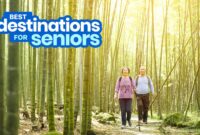Day trips for senior citizens offer a fantastic opportunity to explore new places, engage in enriching activities, and create lasting memories. This guide provides comprehensive information on planning memorable and accessible day trips tailored to the specific needs and preferences of older adults, ensuring a safe, enjoyable, and enriching experience for all.
From selecting suitable destinations and arranging convenient transportation to choosing engaging activities and ensuring safety measures are in place, we’ll cover every aspect of creating a perfect day trip for senior citizens. We’ll explore various transportation options, discuss accessible activities catering to diverse interests and physical abilities, and offer practical tips for budgeting and planning. Our goal is to empower seniors to enjoy fulfilling excursions while prioritizing their comfort and well-being.
Suitable Day Trip Destinations
Planning day trips for senior citizens requires careful consideration of accessibility, ease of travel, and engaging activities. The destinations listed below offer a blend of relaxation, cultural enrichment, and opportunities for gentle physical activity, all while prioritizing comfort and convenience. Each location has been selected for its inherent suitability for older adults, taking into account potential mobility challenges and the desire for a stress-free experience.
Ten Ideal Day Trip Destinations for Senior Citizens
Choosing the right destination is crucial for a successful and enjoyable day trip. The following table provides a selection of locations, considering accessibility and ease of travel for senior citizens. Each location offers unique attractions and caters to diverse interests.
| Location | Transportation Options | Accessibility Features | Notable Activities |
|---|---|---|---|
| Botanical Gardens (e.g., New York Botanical Garden) | Car, taxi, public transportation (check for accessibility on specific routes) | Paved pathways, benches, accessible restrooms, wheelchair rentals available (check availability in advance) | Strolling through themed gardens, enjoying tranquil scenery, visiting conservatories, attending a guided tour (if available) |
| Historical Museum (e.g., Smithsonian National Museum of Natural History) | Car, taxi, public transportation (check for accessibility on specific routes), often with dedicated drop-off points | Wheelchair accessible entrances, elevators, ramps, audio guides, assistive listening devices, seating areas throughout | Exploring exhibits, attending lectures or presentations (check schedules), enjoying interactive displays |
| Coastal Promenade (e.g., Santa Monica Pier) | Car, taxi, public transportation (check accessibility of specific routes), often with dedicated accessible parking | Mostly flat, paved walkways, benches along the route, accessible restrooms, some locations offer mobility scooters for rent | Enjoying ocean views, leisurely stroll, people-watching, perhaps a light meal at a seaside cafe |
| Art Museum (e.g., Metropolitan Museum of Art) | Car, taxi, public transportation (check accessibility on specific routes), often with designated drop-off/pick-up areas | Wheelchair accessible entrances, elevators, ramps, accessible restrooms, seating areas, audio guides | Viewing art collections, attending guided tours (check availability and accessibility), enjoying the museum’s architecture |
| Scenic Train Ride (e.g., Durango & Silverton Narrow Gauge Railroad) | Train (check for accessible carriages and boarding assistance), potentially requiring a car to reach the station | Accessible carriages (check availability in advance and book accordingly), assistance with boarding/disembarking (often available, but confirm beforehand) | Enjoying scenic views, relaxing journey, potentially a themed experience depending on the route |
| National Park (e.g., Acadia National Park – specific accessible areas) | Car (essential), potentially shuttle services within the park (check accessibility and availability) | Designated accessible trails (check park website for details), paved paths, accessible restrooms, some areas may have limited accessibility | Enjoying scenic overlooks, gentle walks on accessible trails, wildlife viewing (from accessible locations) |
| Local Farmers Market | Car, taxi, public transportation (check accessibility of specific routes), often with designated parking | Generally flat surfaces, however, uneven terrain may exist in some areas. Check specific market for details | Browsing fresh produce, interacting with vendors, enjoying local food and crafts |
| Wine Tasting Tour (e.g., Napa Valley – check winery accessibility) | Tour bus (check accessibility and booking options), potentially requiring a car to reach the starting point | Many wineries offer accessible facilities, but it’s crucial to check individual winery accessibility in advance. | Tasting wines, learning about winemaking, enjoying vineyard scenery (from accessible areas) |
| Historical Walking Tour (e.g., a guided tour focusing on a specific neighborhood) | Walking (consider the distance and terrain), potentially using a wheelchair or scooter | Choose tours with paved routes and manageable distances, and inform the tour operator about accessibility needs | Learning about local history, exploring a specific area, enjoying the atmosphere of the neighborhood |
| Drive-in Movie Theater | Car | Comfortable seating within one’s own vehicle, minimal physical exertion required | Enjoying a movie in a relaxed environment, from the comfort of one’s car |
Elaboration on Destination Features and Senior-Friendly Accommodations
Each location offers unique features catering to seniors’ needs and preferences. For example, botanical gardens provide tranquil environments for leisurely strolls, while museums offer stimulating intellectual engagement. Coastal promenades offer refreshing sea air and gentle exercise opportunities. Many locations offer readily available seating, accessible restrooms, and other amenities to enhance comfort and convenience.
Senior-friendly accommodations near these destinations vary widely depending on location. Options often include hotels with accessible rooms, assisted living facilities with day trip programs, and even bed and breakfasts with accessible features. It’s always recommended to book accommodations well in advance and specify accessibility requirements to ensure a comfortable stay. For instance, near the New York Botanical Garden, there are several hotels with accessible rooms and nearby transportation options. Similarly, many hotels near major museums offer accessible rooms and amenities. For coastal locations, hotels often have accessible rooms and elevators, making them suitable for seniors with mobility challenges.
Transportation Considerations
Choosing the right transportation for a senior citizen’s day trip is crucial for ensuring a safe, comfortable, and enjoyable experience. Several factors must be considered, including the seniors’ physical abilities, the distance to the destination, and the group’s size. Careful planning is essential to minimize stress and maximize enjoyment.
Transportation Options for Senior Citizens
Several transportation options cater to the needs of senior citizens embarking on day trips. These include private car transportation, utilizing public transport systems, and joining organized tour groups. Each option presents unique advantages and disadvantages regarding comfort, cost-effectiveness, and accessibility.
Private Car Transportation
Using a private car offers the highest level of convenience and flexibility. Seniors can travel at their own pace, making stops as needed, and choosing the most comfortable route. However, this option can be expensive, particularly if multiple vehicles are required for a large group. Driving long distances can also be tiring for the driver, and parking can be a challenge at popular destinations. Furthermore, this option is unsuitable for seniors who are unable to drive or prefer not to.
Public Transportation
Public transportation, including buses and trains, is a cost-effective option, especially for smaller groups. It often provides accessible routes to many destinations. However, public transport can be less comfortable than private transportation, with potential for overcrowding and delays. Accessibility features, such as ramps and designated seating, may vary depending on the system and specific route. Navigating public transport can also be challenging for seniors unfamiliar with the system or those with mobility issues.
Organized Tours
Organized tours offer a convenient and often stress-free option. Transportation is typically included, with designated pick-up and drop-off points, and drivers handle all the logistics. Tours often provide guided commentary, enriching the experience. However, organized tours can be more expensive than other options and may not offer the same level of flexibility in terms of itinerary and pace. The tour’s accessibility features should be carefully considered to ensure they cater to the needs of senior participants.
Planning Transportation for a Group of Senior Citizens
Planning transportation for a group of senior citizens requires meticulous attention to detail. The first step involves assessing the group’s needs and preferences, including mobility levels and any specific requirements. Once this is established, the most suitable transportation method can be selected. If using a private car, coordinating drivers and vehicles is essential. For public transport, researching routes, schedules, and accessibility features is crucial. Booking tickets in advance, especially for popular routes or during peak seasons, is recommended to avoid disappointment. Clearly defined pick-up and drop-off points, with ample time for boarding and disembarking, are essential for smooth and stress-free travel. Consider providing detailed instructions and maps to assist seniors with navigation.
Using Public Transportation: A Step-by-Step Guide for Seniors
Navigating public transport can present challenges for some seniors. A step-by-step approach can make the process simpler. First, thoroughly research the route, including schedules and accessibility features, using online resources or contacting the transportation provider directly. Next, plan for extra time to account for potential delays or unexpected issues. Ensure all necessary tickets or passes are purchased in advance. At the station or stop, clearly identify the correct platform or bus stop and seek assistance if needed. During the journey, be mindful of personal belongings and remain aware of your surroundings. Upon arrival at the destination, allow ample time to disembark and locate the intended location. If encountering difficulties, don’t hesitate to seek assistance from transport staff or fellow passengers.
Accessibility and Safety
Ensuring the accessibility and safety of senior citizens on day trips is paramount. A well-planned trip considers physical limitations, potential health concerns, and the need for clear communication to create a positive and enjoyable experience. This section details crucial aspects to ensure a safe and comfortable journey for all participants.
Accessibility Challenges and Solutions
Senior citizens may face various accessibility challenges during day trips. These can include limited mobility, visual or hearing impairments, and cognitive limitations. Addressing these challenges requires proactive planning. For example, choosing destinations with ramps and elevators instead of relying solely on stairs can significantly improve accessibility for wheelchair users or those with mobility issues. Similarly, providing large-print brochures or audio guides can cater to visual impairments, while ensuring clear and concise verbal instructions benefits those with cognitive difficulties or hearing impairments. Offering options for seating at regular intervals throughout the day allows for rest periods and avoids overexertion.
Safety Measures for Senior Citizen Day Trips
Thorough planning is crucial for ensuring the safety of senior citizens during day trips. The following safety measures should be implemented:
- Pre-Trip Medical Check-up: Encouraging participants to consult their physician before the trip to assess their fitness for travel and identify any potential health concerns is vital. This allows for appropriate medication management and the identification of any necessary adjustments to the itinerary.
- Emergency Contact Information: Collecting emergency contact details for each participant, including next of kin and medical information, is essential for swift response in unforeseen circumstances.
- First-Aid Kit and Trained Personnel: A well-stocked first-aid kit should accompany the group, and at least one person should be trained in basic first aid and CPR. This ensures prompt and appropriate assistance for minor injuries or medical emergencies.
- Clear Communication and Instructions: Providing clear, concise, and repeated instructions regarding the itinerary, safety procedures, and emergency contacts minimizes confusion and ensures everyone understands the plan.
- Buddy System: Pairing participants, especially those with mobility challenges, with companions can provide extra support and reduce the risk of accidents or getting lost. This system also promotes socialization and camaraderie.
- Weather Contingency Plans: Having alternative plans in case of unexpected weather changes is crucial. This could involve rescheduling activities or seeking indoor alternatives to avoid exposure to harsh conditions.
- Appropriate Footwear and Attire: Advising participants to wear comfortable, supportive footwear and appropriate clothing for the weather conditions is crucial for their comfort and safety.
Accessible Transportation and Accommodation
Selecting accessible transportation and accommodation options is crucial for a comfortable and safe trip. This involves choosing vehicles with ramps or lifts for wheelchair users and ensuring that the chosen destination has accessible restrooms, entrances, and seating arrangements. For example, choosing a hotel with elevators and rooms on ground floors can make a significant difference for those with mobility limitations. Similarly, booking accessible transportation, such as wheelchair-accessible taxis or buses, is essential.
Effective Communication with Senior Citizens
Clear and empathetic communication is vital when planning and executing a day trip for senior citizens. This includes providing ample time for questions and concerns, using clear and concise language, and avoiding overwhelming participants with excessive information. Regular updates about the itinerary, any changes, and safety protocols are important to keep everyone informed and at ease. Consider using visual aids such as maps or photographs to enhance understanding and reduce potential confusion. The use of large font sizes in written materials is also beneficial.
Illustrative Examples
To further illustrate the potential for enjoyable and enriching day trips, let’s consider some specific examples showcasing diverse experiences catering to the needs and preferences of senior citizens. These examples emphasize visual appeal, relaxation, and cultural engagement.
Scenic Boat Ride
Imagine a sun-dappled afternoon on a gently gliding riverboat. A group of senior citizens, their faces illuminated with smiles, are seated comfortably on the deck. The air is filled with the gentle lapping of water against the hull and the cheerful chatter of friends sharing stories and laughter. The scenery unfolds before them – lush green banks, charming riverside villages, and perhaps even majestic wildlife appearing briefly before disappearing back into the reeds. The vibrant colours of the afternoon sun reflecting on the water create a picturesque scene, fostering a sense of peace and shared joy. The camaraderie among the group is palpable, as they connect over shared experiences and the beauty of their surroundings. This leisurely boat ride provides not only visual stimulation but also a sense of tranquility and connection.
Botanical Garden Relaxation
The air hangs heavy with the sweet scent of blooming jasmine and roses. Sunlight filters through the leaves of ancient trees, dappling the paths of a tranquil botanical garden. A group of seniors stroll along, pausing to admire the vibrant colours of exotic flowers and the intricate patterns of leaves. The gentle sounds of birdsong and the rustling of leaves create a calming soundscape. The soft texture of moss underfoot and the gentle breeze on their skin provide tactile and sensory experiences that enhance the feeling of relaxation. Benches offer places to rest and contemplate the beauty of nature. The vibrant colours, aromatic fragrances, and soothing sounds create a truly restorative and peaceful atmosphere, promoting well-being and reducing stress. This tranquil setting offers a welcome respite from the hustle and bustle of daily life.
Vibrant Cultural Experience
The bustling marketplace is a symphony of sights and sounds. A group of senior citizens, immersed in the vibrant atmosphere of a local cultural festival, are captivated by the energy around them. Brightly coloured fabrics, intricate handicrafts, and traditional music fill their senses. The rhythmic beat of drums and the melodic strains of traditional instruments create an engaging soundscape. They engage in friendly conversations with local artisans, learning about their crafts and traditions. The lively interactions and the sharing of stories and laughter create a sense of connection and cultural exchange. The vibrant colours, captivating music, and engaging social interactions provide a stimulating and enriching experience, leaving them with lasting memories and a deeper understanding of the local culture. This immersion in a different culture fosters cognitive stimulation and social engagement.
Final Thoughts
Planning a day trip for senior citizens requires careful consideration of various factors, but the rewards are immeasurable. By thoughtfully selecting destinations, arranging suitable transportation, choosing engaging activities, and prioritizing safety and accessibility, you can create a truly memorable experience that fosters socialization, enhances well-being, and leaves lasting positive impressions. Remember, the focus should always be on creating a comfortable, enjoyable, and enriching day for all participants.




